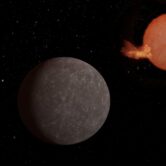(CN) — A study released in the academic journal Nature on Wednesday proposes one potential hurdle to the development of life in the outer solar system may not be as high as it once seemed.
The international team of scientists who conducted the study suggested that there may be greater concentrations of the life-essential element phosphorus on Saturn's oceanic moon Enceladus than were previously thought to exist. And if Enceladus contains more phosphorus than previously thought, so too may the solar system's other watery worlds - like Jupiter's moons Ganymede and Europa.
"Enceladus’s ocean could be a harbinger of high phosphorus availability in subsurface oceans across most of the outer Solar System," the study posits.
Scientists have suggested for years that Enceladus could potentially harbor life. Beneath a protective kilometers-thick outer layer of water ice, the moon is covered by a global water ocean whose environment may be analogous to the deep seas of Earth. Especially if, like on Earth, those dark waters are host to hydrothermal vents. Even without sunlight to drive photosynthesis, life can flourish around hydrothermal vents - warm and rich in dissolved chemicals - by metabolizing inorganic compounds via the alternative process of chemosynthesis. Many complex ecosystems thrive around hydrothermal vents on Earth, sustained by colonies of chemosynthetic bacteria.
But the potential for life on Enceladus, even if it has its own hydrothermal vents, could be curtailed by a lack of phosphorus. It's one of the six elements considered essential for water-based life, alongside carbon, hydrogen, nitrogen, oxygen and sulfur, and the rarest among them. As the study notes, it has not yet been directly observed in any ocean-bearing world besides Earth.
But Wednesday's new study suggests phosphorus may be more abundant on Enceladus than was once thought. To reach their conclusion, the German, Japanese and American scientists who conducted it analyzed ice particles from Saturn's gossamer E-ring, collected between 2004 and 2008 by the now-retired Cassini probe. Within that period, the scientists recorded over 7,300 individual ice grain spectra analyses.
Unlike the gas giant's more striking inner rings, which can be less than a kilometer thick and appear one-dimensional in profile, the outer E-ring is shaped like a giant donut, at some points thousands of kilometers thick. It encircles Saturn in a fine mist of mostly water ice, and at the center of its orbit sits its source - Enceladus itself.
Tidal forces caused by Saturn's gravity constantly stretch and heat the moon, keeping its liquid interior relatively warm and causing pressurized water plumes to shoot up through the icy surface - a phenomenon known as cryovolcanism. The water freezes as it hits Enceladus' thin atmosphere, and some falls back to the surface as snow. The rest escapes into space, forming the E-ring.
Within E-ring ice particles that Cassini gathered, the study's authors detected relatively high concentrations of phosphorus in the form of sodium phosphates. As the E-ring is composed primarily of material from Enceladus' sub-surface ocean, it stands to reason that areas of Enceladus may also be rich in dissolved phosphorous compounds. In some places, perhaps even richer than on Earth.
"The... detection of ice grains with high concentrations of orthophosphates indicates that phosphorus is readily available at the top of Enceladus’s ocean (that is, the plume source region)," the study argues (parentheses in original). "Even with a conservative margin, our estimate indicates concentrations in the order of at least hundreds of micromolar, several 100-fold the average phosphate abundance in Earth’s oceans."
A greater-than-thought concentration of phosphorous within Enceladus' oceans is not smoking-gun proof of the existence of life there. But, as the study asserts, it does show that Enceladus' oceans - and perhaps the oceans of other far-flung moons in our solar system - could possess the right conditions for life to emerge.
"Regardless of... theoretical considerations, with the finding of phosphates the ocean of Enceladus is now known to satisfy what is generally considered to be the strictest requirement of habitability," the study argues.
Subscribe to Closing Arguments
Sign up for new weekly newsletter Closing Arguments to get the latest about ongoing trials, major litigation and hot cases and rulings in courthouses around the U.S. and the world.









